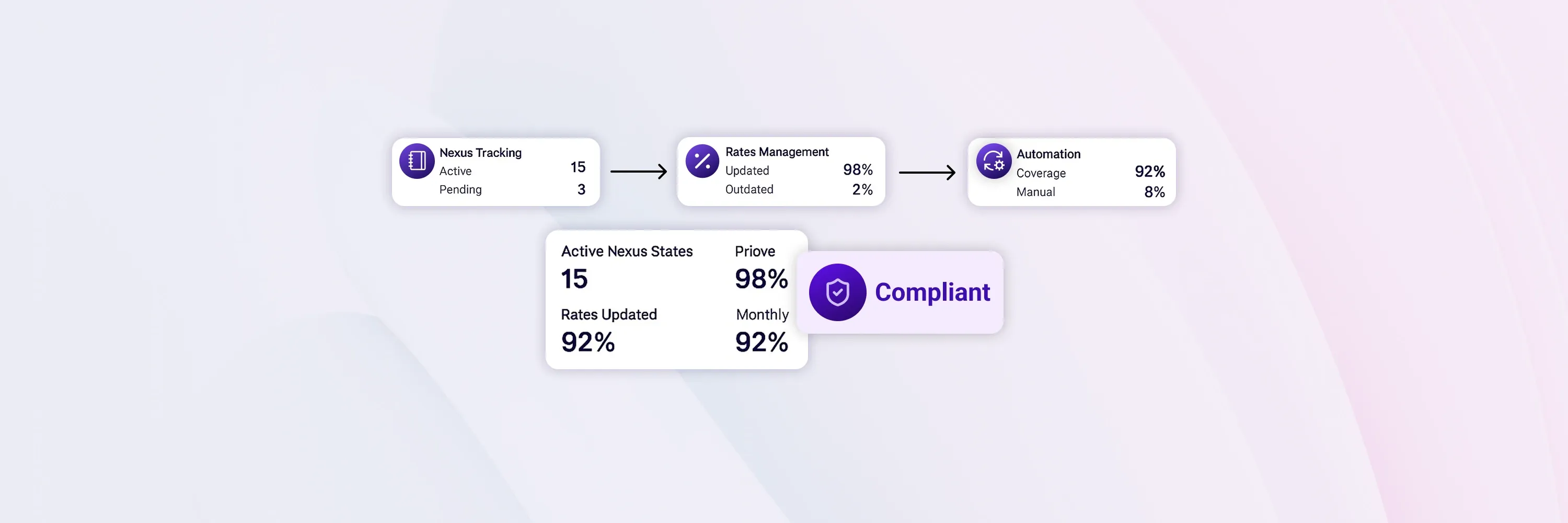
US Sales Tax Explained: State-by-State Guide
Navigating sales tax can feel like a high-stakes scavenger hunt, especially when you're selling across state lines. But what if there is a way to simplify this complex web of regulations?

Navigating sales tax can feel like a high-stakes scavenger hunt, especially when you're selling across state lines. But what if there is a way to simplify this complex web of regulations?
You will learn the nuts and bolts of U.S. sales tax, how state differences affect your invoices, and the key steps to remain compliant - from nexus evaluation to proper registration and filing. Because sales tax rates in the U.S. differ not only by state but also by county and city, businesses face a patchwork of obligations that can be difficult to manage without a clear system. This guide provides a practical framework to identify where you owe tax, track rate changes, and implement reliable processes that satisfy auditors while supporting your growth across multiple jurisdictions.
State legislators set their own sales tax laws. Local counties and cities can layer additional percentages. Altogether, these pieces make up thousands of rate combinations.
Key terms to lock in:
Before you can collect and remit sales tax, you need to confirm where your business has nexus - a legal connection with a state that creates a tax obligation. The 2018 Supreme Court case South Dakota v. Wayfair, Inc. reshaped this landscape, giving states the right to require tax collection even from businesses with no physical presence, as long as they cross certain economic thresholds.
Physical nexus (traditional triggers):
Offices, branches, or corporate locations in the state
Warehouses or storage facilities
Remote employees or contractors working in the state
Inventory stored in third-party fulfillment centers (e.g., Amazon FBA)
Economic nexus (introduced after Wayfair):
States now set revenue or transaction thresholds that trigger obligations
Common standards: $100,000 in sales or 200 transactions annually
Exact thresholds vary by state, so tracking your data is essential
1. Map all shipping origins, FBA warehouses, and remote staff locations. 2. Export revenue and transaction counts by ship-to state for the last trailing 12 months. 3. Compare against each state’s thresholds, updated yearly.
Sales tax isn't a one-size-fits-all concept. In the U.S., each state has its own distinct sales tax laws, creating a complex patchwork of regulations.

Even among states with a sales tax, the rates and rules vary widely. For instance, some states have high state-level rates, while others have low state rates but allow for significant local add-ons, which can lead to a much higher combined rate. Understanding these state-level differences is the key to accurate compliance.
Not all items are taxable statewide: 45 states and the District of Columbia levy a statewide sales tax, whereas five states, Alaska, Delaware, Montana, New Hampshire, and Oregon, do not. Even among states with a sales tax, the rates and rules vary widely.
Compare critical variables:
Create a matrix that lists products across the top and states down the side. Mark taxable, exempt, or reduced-rate cells to ensure flawless invoicing logic. Understanding sales tax isn't just about knowing the big numbers; it's about navigating the granular details of state-specific rules.
Rates change frequently as counties vote on new levies.
To better track these changes and leverage technology, dive into our Global Sales Tax Solutions & VAT Compliance Guide
Once you've determined where you need to collect sales tax, the next step is to make it official and keep up with your obligations.
Once Nexus exists, it is illegal to collect tax without a permit.
Here’s a step-by-step process on registration and compliance across the states
Registration essentials:
Filing cadence:
After determining your Nexus obligations and registering with the appropriate states, the next crucial step is to handle the sales tax correctly. This involves three key actions: collecting the right amount from your customers, accurately reporting your sales, and remitting the funds to the state.
Miscoding a single tax line can poison an audit sample and cause extrapolated liabilities:
Record-keeping must-haves:
For growing businesses, the final piece of the puzzle isn't just about coping with the ongoing challenges, but building a foundation for future growth.
When your business starts operating in more U.S. states, handling exemption documentation properly becomes essential - it helps avoid audit risks and ensures you're compliant.
Key steps:
Managing US sales tax across multiple jurisdictions is a continuous process. You’ll need to determine nexus, understand state differences, track changing sales tax rates US, register promptly, and ensure accurate collection and remittance. This state-by-state framework gives finance teams a clear path to meet U.S. sales tax obligations, expand nationwide sales, and keep compliance risks under control.
Free consultation with 1StopVAT experts
Discover more insights and articles